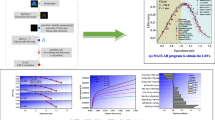Abstract
A comprehensive experimental and numerical study has been conducted to understand the influence of CH3Cl addition on CH4/O2/N2 premixed flames under oxygen enrichment. The laminar flame speeds of CH4/CH3Cl/O2/N2 premixed flames at room temperature and atmospheric pressure are experimentally measured using the Bunsen nozzle flame technique with a variation in the amount of CH3Cl in the fuel, equivalence ratio of the unburned mixture, and level of oxygen enrichment. The concentrations of major species and NO in the final combustion products are also measured. In order to analyze the flame structure, a detailed chemical kinetic mechanism is employed, the adopted scheme involving 89 gas-phase species and 1017 elementary forward reaction steps. The flame speeds predicted by this mechanism are found to be in good agreement with those deduced from experiments. Chlorine atoms available from methyl chloride inhibit the oxygen-enhanced flames, resulting in lower flame speeds. This effect is more pronounced in rich flames than in lean flames. Although the molar amount of CH3Cl in the methane flame is increased, the temperature at the post flame is not significantly affected, based on the numerical analysis. However, the measured concentration of NO is reduced by about 35% for the flame burning the same amount of methyl chloride and methane at the oxygen enrichment of 0.3. This effect is due to the reduction of the concentration of free radicals related to NO production within the flame. In the numerical simulation, as CH3Cl addition is increased, the heat flux is largely decreased for the oxygen-enhanced flame. It appears that the rate of the OH + H2 → H + H2O reaction is reduced because of the reduction of OH concentration. However, the function of CH3Cl as an inhibitor on hydrocarbon flames is weakened as the level of oxygen enrichment is increased from 0.21 to 0.5.
Similar content being viewed by others
References
R. K. Tanner, “Incineration of industrial waste,” Prog. Energy Combust. Sci., No. 5, 245–252 (1979).
H. Valeiras, A. K. Gupta, and S. M. Senkan, “Laminar burning velocities of chlorinated hydrocarbon-methane-air flames,” Combust. Sci. Tech., 36, 333–357 (1984).
K. Y. Lee, M. H. Yang, and I. K. Puri, “Numerical simulation of stoichiometric premixed flames burning CH3Cl/CH4/air mixtures at atmospheric pressure with a full and short reaction mechanism and comparison of the flame speeds with experimental results,” Combust. Flame, 92, 419–439 (1993).
C. E. Baukal (Jr), Oxygen Enhanced Combustion, CRC Press, Boca Raton (1999), pp. 9–42.
T. Morel, “Comprehensive design of axisymmetric wind tunnel contraction,” ASME J., Fluid Eng., 97, No. 2, 225–233 (1975).
B. Rogg, in:, N. Peters and B. Rogg (eds.), Reduced Kinetic Mechanisms for Applications in Combustion Systems, Springer-Verlag, Berlin-Heidelberg (1993).
B. Rogg, “RUN-1DL: The Universal Laminar Flame and Flamelet Computer Code,” User Manual (1994).
J. C. Leylegian, D. L. Zhu, C. K. Law, and H. Wang, “Experiments and numerical simulation of the laminar flame speeds of dichloromethane and trichloromethane,” Combust. Flame, 114, 285–293 (1998).
K. Y. Lee, T. H. Nam, H. S. You, and D. S. Choi, “The flame structure of freely propagating CH4/O2/N2 premixed flames on the O2 enrichment,” Trans. Korean Soc. Mech. Eng., 26, 555–560 (2002).
G. P. Miller, “The structure of a stoichiometric CCl4-CH4-air flat flame,” Combust. Flame, 101, 101–112 (1995).
S. S. Shin, “The influence of CH3Cl on CH4/CH3Cl/O2/N2 premixed flames under the O2 enrichment,” MS Thesis, Andong National University (2004), pp. 66–90.
W. E. Wilson, J. T. O’Donovan, and R. M. Fristron, “Flame inhibition by halogen compounds,” Proc. Combust. Inst., 12, 929–942 (1969).
C. K. Westbrook, “Inhibition of hydrocarbon oxidation laminar flames and detonation by halogenated compounds,” Proc. Combust. Inst., 19, 127–141 (1982).
S. S. Ronald, E. P. James, and I. Doren, “The physical and chemical action of fire suppressants,” Fire Safety J., 15, 437–450 (1989).
S. R. Turns, An Introduction to Combustion, McGraw-Hills (1996), p. 475.
T. Takeno and M. Nishioka, “Species conservation and emission indices form flames described by similarity solutions,” Combust. Flame, 92, 465–468 (1993).
Author information
Authors and Affiliations
Additional information
__________
Translated from Fizika Goreniya i Vzryva, Vol. 42, No. 6, pp. 103–111, November–December, 2006.
Rights and permissions
About this article
Cite this article
Shin, S.S., Vega, E.V. & Lee, K.Y. Experimental and numerical study of CH4/CH3Cl/O2/N2 premixed flames under oxygen enrichment. Combust Explos Shock Waves 42, 715–722 (2006). https://doi.org/10.1007/s10573-006-0106-7
Received:
Issue Date:
DOI: https://doi.org/10.1007/s10573-006-0106-7




